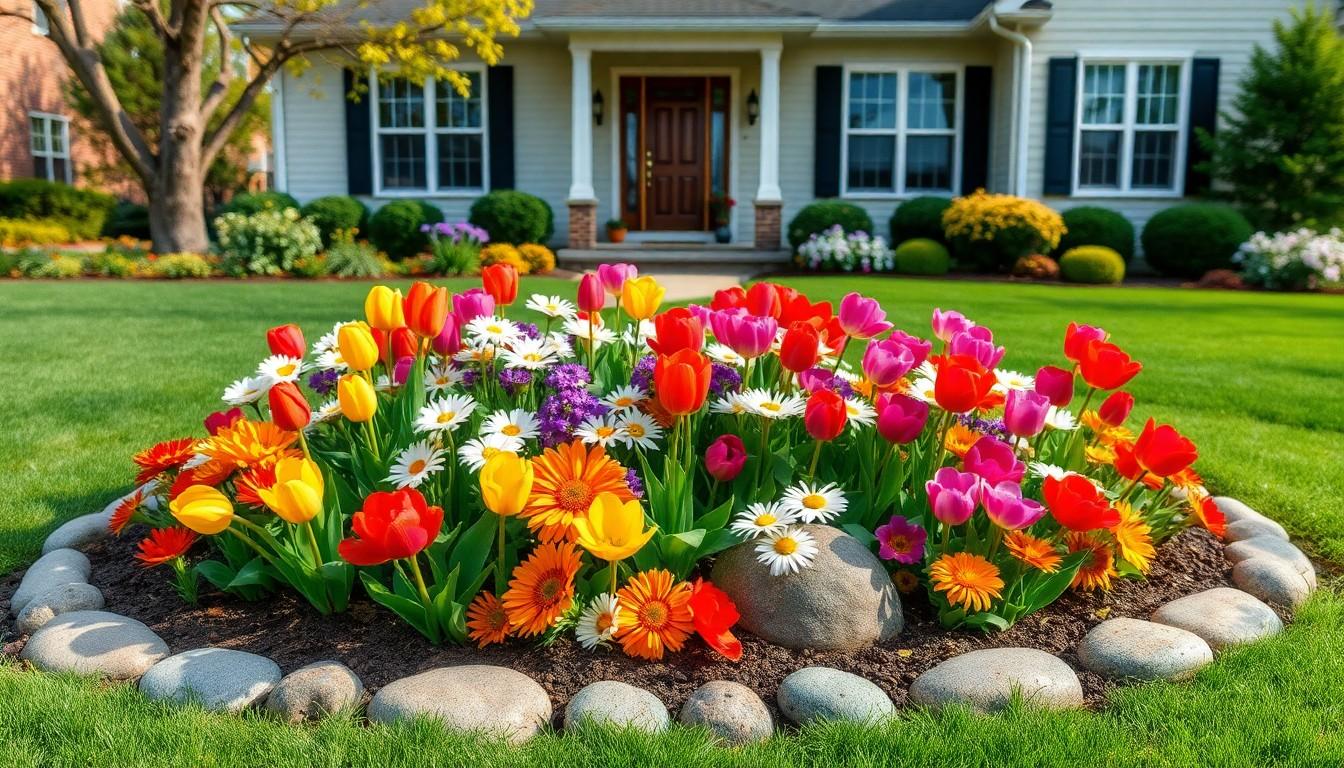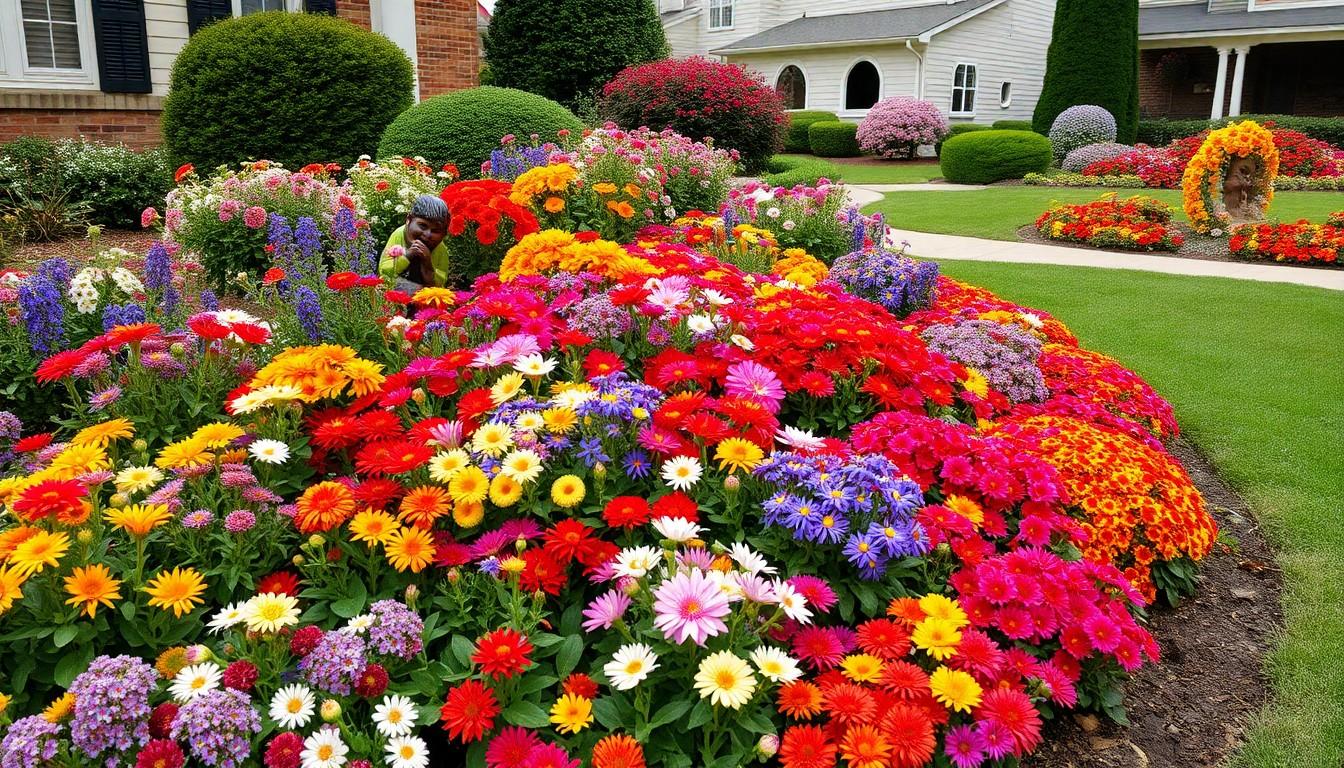Transforming a front yard into a floral masterpiece isn’t just about aesthetics; it’s about making a statement. Picture this: a vibrant flower bed that not only welcomes guests but also makes the neighbors a tad envious. With the right landscaping ideas, that dull patch of dirt can become the talk of the block—who knew daisies could spark such jealousy?
From whimsical designs to elegant arrangements, the possibilities are endless. Whether you’re a seasoned gardener or a budding enthusiast, there’s something here for everyone. Let’s dive into some creative flower bed ideas that’ll have your front yard blooming brighter than a sunflower in July, while keeping your style and personality front and center. After all, why settle for ordinary when extraordinary is just a few plants away?
Front Yard Flower Bed Landscaping Ideas
Creating a captivating front yard starts with well-planned flower beds. Consider a mix of perennial and annual flowers for sustained color throughout the seasons. Select native plants, as they require less maintenance and support local wildlife.
Arranging flowers in clusters enhances visual impact and encourages a cohesive design. Use taller plants at the back of the bed, gradually transitioning to shorter varieties in the front. This tiered approach adds depth and dimension to the landscape.
Incorporating seasonal blooms adds excitement and variation. Plant spring flowers like tulips and daffodils to welcome the warmer months. Summer offers options like sunflowers and zinnias, while fall brings vibrant colors with asters and chrysanthemums.
Utilize decorative elements to enhance the flower beds. Garden statues, decorative stones, and mulch can create texture and interest. Incorporate pathways or stepping stones to guide visitors through the floral display.
Adding variety of colors can transform the front yard into a visual feast. Combine complementary hues, such as purple and yellow, for striking contrasts. Consider using a monochromatic scheme for a more elegant look, showcasing various shades of a single color.
Integrating outdoor lights can highlight the flower beds after dark. Solar-powered stakes or LED spotlights draw attention to key features. Proper lighting creates an inviting atmosphere, allowing the beauty of the landscaping to shine even at night.
Experimenting with flower bed shapes also brings creativity to the design. Curved borders soften the landscape, while geometric shapes provide a more structured appearance. Tailoring shapes to fit the yard’s dimensions adds a personalized touch.
Cultivating a flower garden enhances curb appeal and reflects individual style. Every choice, from plant selection to layout design, contributes to the overall impression. Engaging with these diverse ideas allows for a truly unique front yard flower bed.
Benefits of Flower Bed Landscaping

Flower bed landscaping presents numerous advantages, enhancing both aesthetics and ecological balance. These perks turn a front yard into a vibrant, welcoming space.
Aesthetic Appeal
Visual interest captures attention, and a well-designed flower bed serves as a beautiful focal point. Flowers deliver bursts of color throughout the seasons, showcasing varied blooms ranging from bright tulips to delicate daisies. Unique arrangements of various heights create depth, bringing texture and dimension to the landscape. Curved or geometric designs add an artistic touch, allowing creativity to thrive. Decorative elements, such as stones or garden ornaments, enhance the overall look. Ultimately, a striking flower bed not only impresses guests but also elevates the entire neighborhood’s charm.
Environmental Impact
Flower beds contribute positively to local ecosystems. Native plant selections support local wildlife by offering food and shelter. Pollinator-friendly flowers attract bees, butterflies, and other beneficial insects, promoting biodiversity. Moreover, these plants provide essential habitats for birds and beneficial organisms. They play a role in improving air quality by absorbing carbon dioxide and releasing oxygen. Additionally, well-placed flowers help with soil erosion, so they contribute to a healthier environment. Flower beds create a balance between beauty and ecological responsibility.
Choosing the Right Flowers
Selecting the right flowers is crucial for creating a stunning front yard flower bed. A well-thought-out choice enhances beauty and assures a vibrant display throughout the seasons.
Annual vs. Perennial Flowers
Annual flowers bloom for one season, providing vibrant color and variety. Popular choices include marigolds, petunias, and impatiens. Perennials, on the other hand, return year after year with minimal upkeep. Options like lavender, daylilies, and coneflowers create lasting interest and reliability. Combining both types results in continuous blooms and an evolving landscape. Mixing annuals as fillers among perennials adds instantaneous bursts of color while the perennials mature.
Seasonal Flower Selection
Seasonal flower selection ensures dynamic changes in the flower bed. Spring choices like tulips and daffodils usher in vibrant blooms, while summer favorites such as zinnias and sunflowers bring warmth and brightness. For fall, asters and chrysanthemums provide rich hues as winter approaches. Selecting flowers based on seasonal interest enhances visual appeal throughout the year. It’s essential to factor local climate and specific growing conditions into these decisions for optimal results. This approach creates a well-balanced and lively floral display in the front yard.
Flower Bed Design Concepts
Innovative flower bed designs enhance front yard aesthetics. Various styles cater to diverse tastes and preferences.
Traditional Flower Beds
Traditional flower beds often feature classic plant arrangements. These setups utilize perennial flowers alongside annuals for continuous bloom. Plants like roses, daisies, and peonies create a timeless appeal. Adding a mix of heights and textures ensures a dynamic visual experience. Garden borders made of stones or bricks enhance structure and guide viewers’ eyes. To maintain a cohesive look, complementary colors and plant shapes unify the design. Detailed consideration of seasonal changes ensures vibrancy throughout the year.
Modern and Minimalist Designs
Modern flower bed designs focus on simplicity and clean lines. These ideas include fewer plant varieties for an uncluttered appearance. Using geometric shapes like squares or circles adds a contemporary vibe. Incorporating native plants supports local ecosystems while minimizing maintenance requirements. Neutral color palettes paired with bold plant choices create striking contrasts. Hardscape elements such as mulch or gravel can replace excessive greenery, emphasizing negative space. Light fixtures strategically placed illuminate the flower beds, showcasing their beauty at night.
Maintaining Your Flower Bed
Maintaining a flower bed ensures its vibrancy and health. Consistent care leads to a thriving landscape filled with color and life.
Watering Strategies
Watering practices directly affect flower health. Regularly check soil moisture levels by feeling the soil about an inch deep. Early morning or late afternoon serve as ideal times for watering, minimizing evaporation. Applying water at the base of plants targets root systems effectively. Consider using drip irrigation systems to provide consistent moisture while saving resources. Mulching around plants retains soil humidity and reduces weed growth. Adjust the frequency based on weather conditions, ensuring proper hydration during hot, dry periods.
Pest Control Tips
Pest management keeps flower beds thriving. Inspect plants frequently for signs of infestation, such as discolored leaves or holes. Handpicking larger pests like slugs and caterpillars offers immediate control. Natural remedies, such as neem oil or insecticidal soap, effectively deter unwanted insects. Beneficial insects, like ladybugs and lacewings, contribute positively by preying on harmful pests, so consider attracting them. Proper plant spacing improves air circulation, reducing fungal diseases. Regularly removing debris and dead plants also minimizes pest habitats, promoting a healthy flower bed environment.
Conclusion
Creating a stunning front yard flower bed is a rewarding endeavor that reflects personal style while enhancing curb appeal. By thoughtfully selecting a mix of annuals and perennials and incorporating seasonal blooms, anyone can achieve a vibrant display throughout the year.
Innovative designs and well-chosen plants not only beautify the landscape but also support local ecosystems, attracting pollinators and improving air quality. With proper maintenance and care, these flower beds can flourish, turning an ordinary yard into an extraordinary outdoor space. Embracing creativity in flower bed landscaping invites a unique charm that’s sure to impress.
